Cargo chief quits WestJet as freighter operations cease
WestJet Cargo is losing both its freighters and its head of cargo, after its freight ...

Global trade is alive and well – but the global health situation is continuing to distort trade patterns and creating uncertainty, two multinational forwarders said today.
Predictions are hard to make: will western economies start to embrace services over goods as vaccinations ease restrictions?
In an attempt to read the demand better, Flexport has launched a new indicator, based on its own data, combined with US consumption behaviour.
The monthly Flexport Post-Covid Indicator examines the correlation between shipping flows, and US demand for ...
Asia-USEC shippers to lose 42% capacity in a surge of blanked sailings
USTR fees will lead to 'complete destabilisation' of container shipping alliances
Outlook for container shipping 'more uncertain now than at the onset of Covid'
New USTR port fees threaten shipping and global supply chains, says Cosco
Transpac container service closures mount
DHL Express suspends non-de minimis B2C parcels to US consumers
Zim ordered to pay Samsung $3.7m for 'wrongful' D&D charges
Flexport lawsuit an 'undifferentiated mass of gibberish', claims Freightmate
Uncertainty over US tariffs sparks interest in bonded warehouses for imports
Cancelled voyages take the sting out of spot rate declines this week
Shippers warned: don't under-value US exports to avoid tariffs – 'CBP will catch you'
Blanked sailings in response to falling demand 'just a stop-gap solution'

Comment on this article